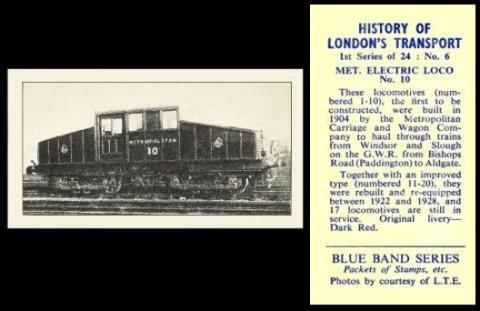
This card gave us "electric" for it is a Metropolitan Line electric locomotive.
Electric power may be convenient, and allow us to just flick a switch and light our homes, but it is very wasteful of resources. The first thing is that the fossil fuel that we make it from sends various greenhouses gases into the atmosphere, and a recent study showed that two thirds of the energy made is wasted, released as heat and steam. However electricity generated in other ways can be green - and we will show you some of those for the rest of the week.
Electric locomotives were first used on the London Underground in 1890, on the City and South London Line, which ran for just over three miles in a pair of tunnels that carved their way beneath the River Thames. The reason or their electrification was because it was such a short journey that it was not possible to drill breathing holes to the surface in order for the steam to escape (as was done by both the District Line and the Metropolitan Line, which used steam locomotives.
It was not until 1903 that these two lines started to tinker with electricity, and actually the far extents of the lines continued to shift to steam locomotives for many decades, leaving electricity only inside the bounds of London. The Metropolitan Line actually were helped in this by buying the majority (two of the three) electric locomotives from the defunct City and South London Railway - and one of the was only scrapped in 1942.
Our card tells us that the first ten electric locomotives (numbered 1 to 10), were "built in 1904 by the Metropolitan Carriage and Wagon Company. Railway", and they took "through trains from Windsor and Slough on the Great Western Railway from Bishop`s Road (Paddington) to Aldgate" which is still the end of the line today. of them, all looked like the one on our card. They first rode the rails in 1906 and pretty soon after gained the rather derisory name of "Camel-backs". And they lasted until the 1920s, when faster and more powerful trains came along - though our card expands a bit on this, telling us that "Together with an improved type (numbered 11-20) they were rebuilt and re-equipped between 1922 and 1928, and 17 locomotives are still in service. Original livery - Dark Red".
And we know of two that are still alive, one of which is at the London Transport Museum, so is presumably the very machine on our card, for that says at the end "Courtesy of L.T.E.", and that was The London Transport Executive, the organisation responsible for public transport in Greater London from 1948 until 1962, when it was replaced by the London Transport Board.
As for our set, it is first listed in our original British Trade Index part two, as :
BLUE BAND Series
Packets of Stamps, etc. Cards issued in 1950s
- HISTORY OF LONDON`s TRANSPORT. Sm. 70 x 37. Front in a) black, b) blue, and c) red.Nd. (24) ... BLV-1
We are delighted to say that we have now featured all three of the colours for this set on this website, so you can see the black here, the blue in our newsletter for the 25th of October 2025 (scroll down to Saturday the 25th), and the red in our newsletter of the 17th of June 2023 (scroll down to Thursday the 22nd)
Blue Band also issued "See Britain by Coach" in the same year, 1954 - a set which was five years later issued by Gee`s Food, though I have a note to say that food might have been Gee`s main trade, but the cards were issued with Red Stripe Sweet Cigarettes.
There is something more though, for in our original British Trade Index part four, it suddenly lists, at the back of the book,
- Set ZB9-83. History of London`s Transport - 2nd Series of 24. 68 x 38. Back per ZB9-83. Issued by Blue Band in the 1950s, second series to set BLV-2 in II ... ZB9-83
This must have been a new discovery, subsequent to the printing of that volume, for in our updated British Trade Index part four, the two are reunited as :
BLUE BAND Series
Inserted in packets of Stamps. Issued early 1854-55
- HISTORY OF LONDON`s TRANSPORT. 70 x 37. Nd. (24). Front in a) black, b) blue, and c) red. ... BLU-100
- HISTORY OF LONDON`s TRANSPORT - 2ND SERIES. 68 x 38. Nd. (24). Anonymous printed full text back. ... BLU-110
The big question for you to work on is who was Blue Band ? Was it a company called Blue Band, or was it someone else who issued various packets of stamps with coloured bands to distinguish them from each other ? Or is this is question for our philatelic friends...?
